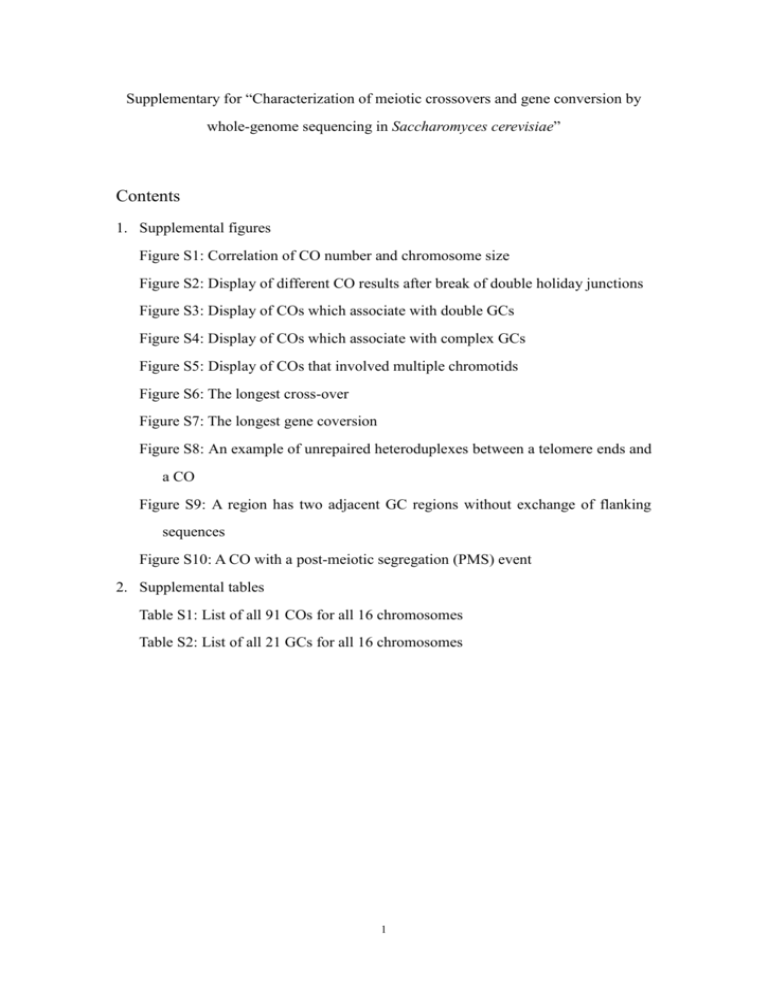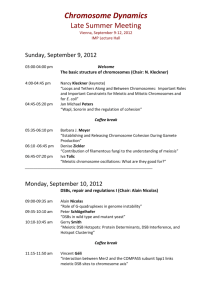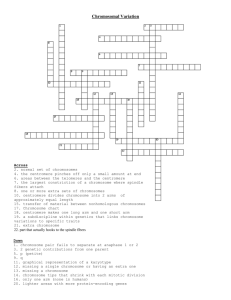Supplementary for “Characterization of meiotic
advertisement

Supplementary for “Characterization of meiotic crossovers and gene conversion by whole-genome sequencing in Saccharomyces cerevisiae” Contents 1. Supplemental figures Figure S1: Correlation of CO number and chromosome size Figure S2: Display of different CO results after break of double holiday junctions Figure S3: Display of COs which associate with double GCs Figure S4: Display of COs which associate with complex GCs Figure S5: Display of COs that involved multiple chromotids Figure S6: The longest cross-over Figure S7: The longest gene coversion Figure S8: An example of unrepaired heteroduplexes between a telomere ends and a CO Figure S9: A region has two adjacent GC regions without exchange of flanking sequences Figure S10: A CO with a post-meiotic segregation (PMS) event 2. Supplemental tables Table S1: List of all 91 COs for all 16 chromosomes Table S2: List of all 21 GCs for all 16 chromosomes 1 Part 1. Supplemental figures Figure S1. Correlation between CO number and chromosome size. A linear relationship between CO number per chromosome and chromosome size is well supported by counting 4161 COs from 46 meiosis (Steinmetz’s data) with correlation coefficient squared as R2=0.985. 2 Figure S2. Different CO possible results after resolution of double holiday junctions. Nicks in the same strands (horizontal arrows) for left junctions and nicks in the other strands (vertical arrows) for right junctions lead to the left type, otherwise to the right type. Each type could give four different results due to different DNA repairing outcomes (which strand is used as the “correct” one). Among the resulting 8 types, 3 COs only contain 1:3 (or 3:1) GCs and are denoted as “Single GC”; 3 COs containing one 1:3 GC (or 3:1 GC) and 2:2 GC as “Double GCs”; the remaining 2 CO types as “Complex GCs”. We note that a “Complex GC” could be seen as a “Double GC” due to insufficiency of sequence divergence and a “Double GC” could also appear as a “Single GC” due to a lack of SNPs. 3 Figure S3. Display of COs which associate with double GCs. (A) A CO with the meiotic chromatids #1 and #2 to form a 2:2 GC and a 3:1 GC (chromosome 4: 1,116,902~1,127,539bp). (B) A CO with the meiotic chromatids 2 and 3 to form a 2:2 GC and a 1:3 GC (chromosome 12: 609,793~616,058bp). (C) A CO with the meiotic chromatids 2 and 3 to form a 1:3 GC and a 2:2 GC (chromosome 16: 695,784~700,040bp). (D) A CO with the meiotic chromaids 2 and 3 to form a 1:3 GC and a 3:1 GC (chromosome 6: 221,516~226,608bp). (E) A CO with the meiotic chromatids 3 and 4 to form a 3:1 GC and a 1:3 GC (chromosome 12: 317,990~325,272bp). 4 Figure S4. One case of COs with meiotic chromatids 1 and 2 with complex GCs is shown and a 1:3 GC, a 2:2 GC and a 3:1 GC inside (chromosome 16: 253,089~256,671bp). 5 Figure S5. Three COs with the multiple chromotids being involved. (A) A CO that exchanged sequences of the meiotic chromatids 2 and 3 and that converted chromatid 1 sequences (chromosome 4: 125,548~130,518bp). Details of PCR and sequencing for product 1, S288C and RM11 are displayed in the lower graph. (B) A CO that exchanged sequences of the meiotic chromatids 2 and 4 and converted that of chromatid 3 (chromosome 10: 331,929~334,120bp). (C) A CO with exchange of sequences of the meiotic chromatids 2 and 4 and conversion of that of chromatid 1 (chromosome 14: 422,748~431,065bp). 6 Figure S6. Display of two longest COs . (A) Display of the longest CO (according to COs’ maximum size, 10,637bp) with the meiotic chromatids 1 and 2 (chromosome 4: 1,116,902~1,127,539bp). (B). Display of the longest CO (according to COs’ minimum size, 8,322bp) with the meiotic chromatids 3 and 4 (chromosome 15: 19,470~27,792bp). 7 Figure S7. Display of the longest GC (according to GCs’ minimum size, 6542bp) with the conversion of meiotic 899,794~906,336bp). 8 chromatid 4 (chromosome 12: Figure S8. A 10kb region with unrepaired heteroduplexes and PCR results. (A) Display of reads mapping between a telomere ends (around 11,647bp) and a CO (around 19,470bp). (B) The PCR and sequencing results show nucleotide of “G” and “T” on S288C and RM11 respectively and a mixture of “G” and “T” on the meiotic product 4. 9 Figure S9. A region on chromosome 7 has two adjacent GC regions without exchange of flanking sequences; this suggests that double-Holliday junctions might still be revolved to form NCOs. 10 Figure S10. A CO with a post-meiotic segregation (PMS) event and PCR results. (A) Display of reads mapping of this region (chromosome 15: 22,457~27,792bp). (B) Displays of the proof from PCR products around position 22,623bp. PCR products for S288C and RM11 showed nucleotides at this position as “C” and “T” respectively; the sequence for meiotic chromatid 3 was a mixture of “C” and “T”. 11 Part 2. Supplemental tables Table S1. List of all 91 COs for all 16 chromosomes Chromosome Start position End position Involved products ch01 ch01 ch01 ch02 ch02 ch02 ch02 ch02 ch03 ch03 ch04 ch04 ch04 ch04 ch04 ch04 ch04 ch04 ch04 ch04 ch04 ch05 ch05 ch06 ch06 ch06 ch07 ch07 ch07 ch07 ch07 ch07 ch07 ch08 ch08 ch08 ch08 ch09 ch09 ch09 ch10 ch10 ch10 ch10 ch10 ch10 ch11 ch11 ch11 ch11 64484 109736 191698 196420 359976 458913 639422 700731 51650 235557 60461 125548 386142 505249 588709 687629 770349 1019306 1116902 1267942 1474562 222252 489422 92117 196304 221516 272231 418506 436342 579231 799618 849139 941031 203881 211544 397790 513025 95341 274412 298781 78221 120287 279698 331929 465014 558307 24444 309395 459289 580805 65432 116328 192334 196584 360860 460196 644140 705101 53891 239953 63840 130518 388144 505545 589438 694030 774846 1022767 1127539 1270025 1474877 222508 492124 94475 197390 226608 273430 420888 440698 582804 802065 850855 943674 209089 218191 398621 518911 97661 274971 303587 81026 121721 282733 334120 466324 560030 24925 310151 460859 585871 12 2, 4 2, 4 3, 4 3, 4 3, 4 2, 3 2, 4 1, 2 1, 3 2, 4 1, 4 2, 3 1, 2 2, 4 1, 3 3, 4 3, 4 3, 4 1, 2 2, 4 2, 3 3, 4 2, 3 1, 3 3, 4 2, 3 2, 4 1, 4 3, 4 2, 4 2, 3 1, 2 1, 2 2, 4 1, 3 3, 4 2, 3 2, 4 1, 3 1, 3 3, 4 1, 2 1, 4 2, 4 2, 4 1, 3 1, 2 1, 2 3, 4 3, 4 ch12 ch12 ch12 ch12 ch12 ch12 ch12 ch12 ch13 ch13 ch13 ch13 ch13 ch13 ch14 ch14 ch14 ch14 ch14 ch14 ch14 ch14 ch15 ch15 ch15 ch15 ch15 ch15 ch15 ch15 ch15 ch16 ch16 ch16 ch16 ch16 ch16 ch16 ch16 ch16 ch16 37551 127005 317990 397606 609793 872179 986364 1054966 41051 156894 221398 382193 773436 874295 19742 106213 262514 422748 464235 505442 639289 755402 19470 215175 301320 481862 574822 745307 826033 923564 984989 47416 253089 292698 318071 357944 504268 620612 695784 830978 897732 46413 128382 325272 400452 616058 875362 986651 1058605 43096 161085 223396 382383 774680 876529 23883 107444 263037 431065 467030 507430 644951 757948 27792 222859 303068 483753 577828 747553 827283 926123 988093 51430 256671 299677 325849 360697 507167 625480 700040 832984 902925 1, 4 1, 3 3, 4 2, 3 2, 3 3, 4 1, 3 1, 3 1, 4 1, 4 1, 3 2, 4 2, 4 3, 4 2, 3 2, 3 2, 3 2, 4 3, 4 3, 4 3, 4 1, 2 3, 4 1, 3 2, 4 2, 4 1, 4 1, 4 2, 4 1, 3 1, 4 2, 3 1, 2 1, 3 2, 3 1, 4 1, 3 2, 4 2, 3 3, 4 3, 4 Table S2. List of all 21 GCs for all 16 chromosomes Chromosome Start position End position Converted product ch02 ch02 ch03 ch04 ch04 ch05 ch06 256265 545432 63611 130712 263532 106481 76001 256939 546927 63611 132561 265026 107580 77338 13 4 3 2 1 3 3 1 ch06 ch07 ch07 ch07 ch08 ch10 ch10 ch11 ch12 ch12 ch13 ch13 ch15 ch16 252258 124766 392320 668532 277105 110554 641747 235688 567959 899794 625678 852528 494572 694512 252258 127355 392320 668532 278112 112235 642373 237470 568548 906336 626429 852528 495046 694512 14 1 1,3 2 2 2 1 1 2 4 4 3 1 2 4







